
 |
||||||||
|
|
||||||||
|
|
|
Of actual Medieval and Renaissance martial arts, no living
tradition or extant school or style of historical fighting
skills –as practiced
and taught in those periods –has survived intact
to our present time. As well, no 18th or 19th century
schools and masters of fence retained the old skills of earlier
arms and armor in their curriculum nor did any of them claim
to. Rather, they more or less professed a new refined
and “superior” method of gentlemanly self-defense
directed toward the single combat conditions of the duel of
honor –with decreasing military application. Today’s modern fencing styles –based exclusively on the three tools of foil, epee, and sabre –derive directly from these 18th and 19th century patterns. For many decades these formed the basis for most all approaches to studying any methods of Medieval and Renaissance fencing, particularly systems of theatrical choreography and stage combat theory. Alternatives seldom ranged far from attempts at historically inspired tournament games and martial sports or thinly disguised and repackaged Asian martial arts.
|
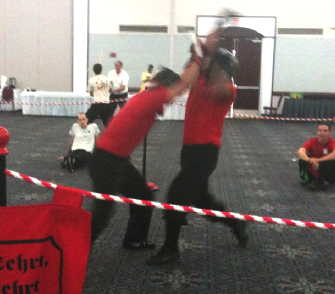 |
|---|
It goes without saying that today Medieval and Renaissance martial arts cannot be earnestly studied or taught within the same historical context under which they originally developed.
|
What Are We Doing and Where Are We Going?Today we find ourselves in a new age of discovery, a Renaissance of the European martial arts. Old superstitions and outdated beliefs are being challenged by new scientific knowledge brought about by the rediscovery of old texts.Due to the rediscovery in recent years of forgotten, lost, or previously unknown European works concerned with self-defence and the handling of arms –particularly swordsmanship, we students of the subject find ourselves in a period of rebirth. Like the carvel ships that took explorers abroad the oceans, we now have our computers that sail the Internet opening routes of communication and trade to bring together a vast community of practitioners, amateur researchers, and historians questioning the outdated assumptions of traditional fencing and who are eager to relearn and bring to back to life our lost martial heritage. |
 Just as the priest and master of arms Hanko Doebringer's in his writings on the teachings of Master Liechtenauer in 1389 complained of the Leichmeisters ("dance masters"), an insult for the show-fighters who instead of knowing the real art only used flashy and ineffective technique for display, we to feel this problem is still with us today. Doebringer stated the reality of swordsmanship was serious and proceeded on the closest and shortest way, quickly and readily; when one wants to strike and thrust in the surest manner as could be done. He noted that rightful swordsmanship did not have any beautiful and broad parries and large motions or fencing around, to impressed unskilled observers people. The Leichmeisters he observed stood still and made large motions slowly and clumsily, creating two or three strokes out of what was really one because they want to be respected by those who do not understand the art, so that they often delayed and missed and in the process exposed themselves. His comments are very telling to us who have criticised the ubiquitous lack of martial intent and authenticity in theatrical combat and modern stunt fighting shows. |
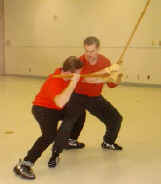 Rather
than trying to fit what we know about period combat into
a preconceived pretend version of it, we instead integrate
what we learn about Medieval and Renaissance fencing into
a system of training and practice that includes mock-combat.
In contrast to the 18th
century definition of fencing as essentially the art of
single sword duelling, ARMA accepts the definition of Medieval
and Renaissance fencing as it originally meant in the periods:
armed combat skills which always incorporated close-in and
unarmed techniques.
Rather
than trying to fit what we know about period combat into
a preconceived pretend version of it, we instead integrate
what we learn about Medieval and Renaissance fencing into
a system of training and practice that includes mock-combat.
In contrast to the 18th
century definition of fencing as essentially the art of
single sword duelling, ARMA accepts the definition of Medieval
and Renaissance fencing as it originally meant in the periods:
armed combat skills which always incorporated close-in and
unarmed techniques.
The ARMA is not concerned with exclusively knightly tournaments sports or later gentlemanly “duels of honor”, but with the whole panoply of personal fighting skills of the period from roughly 1250-1650. The sheer enormity of this subject and its transitory nature, as more material and accurate interpretations appear almost monthly, means we simply cannot be as precise or firm as we would like. Nor can we address every facet of the subject from every historical master’s view. What we can do is offer a reliable starting point and a sound means by which to study.
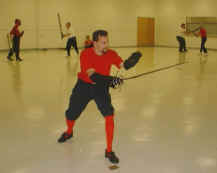 ARMA
endeavors to avoid the commonplace “museum curator”
approach to historical fencing which treats it as a fossilized
cultural artifact. ARMA uses as its model not only
the German Fechtschulen and English fighting guilds of the
16th century, but also follows as its inspiration the first
historical fencing enthusiasts who did much to legitimize
the subject –the late 19th century British practitioner-researchers
Captain Alfred Hutton, Egerton Castle, Sir Frederick Pollock,
Captain Carl Thimm, and Colonel Cyril Matthey.
ARMA
endeavors to avoid the commonplace “museum curator”
approach to historical fencing which treats it as a fossilized
cultural artifact. ARMA uses as its model not only
the German Fechtschulen and English fighting guilds of the
16th century, but also follows as its inspiration the first
historical fencing enthusiasts who did much to legitimize
the subject –the late 19th century British practitioner-researchers
Captain Alfred Hutton, Egerton Castle, Sir Frederick Pollock,
Captain Carl Thimm, and Colonel Cyril Matthey.
 It
is an axiom of martial arts and historical fencing that
only a master or a very skilled fighter can check all the
faults that a beginner is liable to make when learning.
But no one alive today knows what Medieval or Renaissance
styles really looked liked nor how exactly they were passed
on. Obviously there are no living historical masters today
around to teach us. Yet, if we carefully study the illustrations
in the surviving texts, translate their words with precision,
and interpret both based on a sound understanding
of how the weapons in question can actually be employed,
then the historical techniques and principles of the source
manuals are not difficult to reconstruct. We seek
not to produce
students that are technically proficient in movement patterns
yet tactically ineffectual as fighters. We seek instead
the meaning of the authentic historical teachings…and
through analysis, a modern way to practice them once again
as credible martial disciplines. When it comes to Renaissance
martial arts, we concluded, authenticity does not exist
unless we now reconstruct it. This, then, in a nutshell
is what ARMA does.
It
is an axiom of martial arts and historical fencing that
only a master or a very skilled fighter can check all the
faults that a beginner is liable to make when learning.
But no one alive today knows what Medieval or Renaissance
styles really looked liked nor how exactly they were passed
on. Obviously there are no living historical masters today
around to teach us. Yet, if we carefully study the illustrations
in the surviving texts, translate their words with precision,
and interpret both based on a sound understanding
of how the weapons in question can actually be employed,
then the historical techniques and principles of the source
manuals are not difficult to reconstruct. We seek
not to produce
students that are technically proficient in movement patterns
yet tactically ineffectual as fighters. We seek instead
the meaning of the authentic historical teachings…and
through analysis, a modern way to practice them once again
as credible martial disciplines. When it comes to Renaissance
martial arts, we concluded, authenticity does not exist
unless we now reconstruct it. This, then, in a nutshell
is what ARMA does.
To this end, ARMA…- Maintains a network of individuals, students, and Study Groups studying Renaissance martial arts. - Promotes research and scholarship into historical fencing and European martial culture. - Promotes free-play / sparring guidelines for fighting practice. - Encourages training and test-cutting with historically accurate replicas of European swords and weaponry. - Advocates open dialogue and exchange among martial artists, fencers, researchers, historians, and re-enactors within the Historical Fencing community. - Offers a resource base for the study and translation of historical European fighting manuals. - Holds classes, workshops, and seminars, as well as offers lectures and demonstrations. - Offers members a proven system of study that is martially sound and historically valid. |
What does it mean to practice Renaissance Martial Arts?
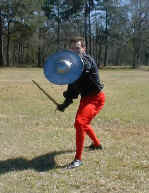 The
historical fencing movement has gained great momentum in
recent years, as more and more serious students have rediscovered
the original historical manuals and realized their value
as unparalleled sources of study. The old orthodox view
of fencing history is fading in light of a new generation
of historical European martial arts practitioners aided
by advances in scholarship and communication.
The
historical fencing movement has gained great momentum in
recent years, as more and more serious students have rediscovered
the original historical manuals and realized their value
as unparalleled sources of study. The old orthodox view
of fencing history is fading in light of a new generation
of historical European martial arts practitioners aided
by advances in scholarship and communication.
To explore and learn our subject requires we conduct pure research and experimentation in the investigation of European arms and armor and their use combined with honest supposition, conjecture, and analysis. For the purpose of developing training sequences, drills, and practice routines we define terminology and identify essential principles and concepts from historical fencing manuals. These efforts aim at establishing a new pedagogy of instruction or Medieval and Renaissance martial arts as combative skills instead of martial sports. Our perspective is that of training and instructing. Hence, in our modern practice now we explore them and try to master them as if they were really intended to be used –even though we realistically know this will never be the case.
 The
domain of Medieval and Renaissance fencing today involves
a multitude of proficiencies. These teachings must be studied
within their own context, following conditions approximating
those they were originally practiced under, and using weapons
and equipment of the same historical styles. The sophisticated
fighting skills of the 13th to 17th
centuries were highly developed and effective. To
learn them again requires considerable research and physical
effort that cannot be acquired except by pursuing them along
a similar historical manner.
The
domain of Medieval and Renaissance fencing today involves
a multitude of proficiencies. These teachings must be studied
within their own context, following conditions approximating
those they were originally practiced under, and using weapons
and equipment of the same historical styles. The sophisticated
fighting skills of the 13th to 17th
centuries were highly developed and effective. To
learn them again requires considerable research and physical
effort that cannot be acquired except by pursuing them along
a similar historical manner.
While the motivation for studying this subject will surely be different for each individual, certain general elements can be identified. These skills are obsolete for modern war and duelling itself is a thing of the past, however there are still genuine self-defence components to be learned. There are of course strong health benefits to be derived from the exercise, stress relief, and physical and mental conditioning found within martial practice. Improved physical fitness and mental well-being as well as character are all well-known aspects of the pursuit of fencing or martial arts. Additionally, within Medieval and Renaissance fencing there are other elements at work such as gaining an appreciation for our Western heritage and history and the ingenuity with which our ancestors met adversity. Finally, the camaraderie found in learning and playing together with fellow students cannot be denied.
Thus, the Association for Renaissance Martial Arts is an educational non-profit organization dedicated to the study and practice of historical fencing and the exploration and promotion of our Western martial heritage. The ARMA focuses on the interpretation and legitimate reconstruction of Medieval and Renaissance combat systems as a modern discipline. The ARMA’s efforts are directed toward resurrecting and recreating a legitimate craft of European fighting skills in a manner that is historically valid and martially sound. Join us in exploring and reviving an exciting world of history and culture!
Programs and Efforts
The
ARMA represents a modern effort at researching, reconstructing,
and resurrecting a legitimate craft of Medieval and Renaissance
martial arts. ARMA material is based exclusively on
documented Western martial culture and experience in handling
real weaponry. Effort is directed at an approximation of
historical fighting skills through a curriculum of interpreted
techniques, principles, concepts, and methods for using
swords, spears, shields, staffs, daggers, and grappling
arts. The ARMA therefore views historical fencing from the
perspective of the art of using all arms.
The ARMA System is founded upon an appreciation of the context under which European combatives of the Medieval and Renaissance era existed. The ARMA recognizes that fencing of earlier centuries was a martial art in the truest and original meaning of the European term –armed and unarmed fighting skills so named for the “Arts of Mars”, Roman god of war. ARMA’s Training Methodology emphasizes the “Martial” in martial arts, and does not suffer the pretense of posing and pretending.
The
ARMA attempts to provide students and enthusiasts with realistic
and effective understanding of martial skills, and not merely
interesting intellectual recreation or academic demonstration
of period styles. The subject is viewed by ARMA as a means
of appreciating our martial heritage and its ingenuity,
the adversity of life in earlier ages and the need for practical
self-defense, as well as developing our fitness and character. We offer
a Member
Training Program of Workshops
and Seminar classes in Renaissance martial arts designed
for both novice enthusiasts and serious practitioners.
See also Students
and Ranking Within ARMA. We provide a private
Member’s area of study material sand training aids.
We also feature a Youth
page to help educate kids and teens under
16 in Chivalric values and develop interest in the positive
aspects of the martial heritage of Western civilization. The
ARMA system for study of Medieval and Renaissance fencing,
as presented in classes, seminars, and the National
Training Program
workshops utilizes the our Study Approach and Training Methodology
within the ARMA
System. In
simplest turns, the ARMA Study Approach
is the reliance upon the source manuals of the historical
European Masters of Defence as the sole authority for reconstruction;
the reliance on historically accurate replicas weaponry;
and trust upon hands-on interpretation using all of these.
The ARMA Training Methodology
is the use of wooden weapons (wasters) and blunts for exercises
and drills; the use of padded-weapons for free-play (or
contact-sparring); and the use of sharps for test-cutting
practice. The overwhelming evidence persuasively convinces
us that historically, training in Renaissance martial
arts involved a number of key practices: the first, partnered
exchanges of attack and defense sequences in order to
learn the fundamental execution of core movements with
regard to certain key principles of fighting; the second,
exercise repetitions of techniques in order to strike
strongly and quickly with accuracy; the third, conducting
forms of play-fighting in order to acquire adversarial
counter-timing, the perception to be deceptive while not
being deceived, and a grasp of the tactical application
of techniques; and the fifth, performance of combinations
of actions in a open-ended chain of spontaneous movements
so as to demonstrate coordination and fluid motion. This
then, is the central effort of ARMA's system and curricula.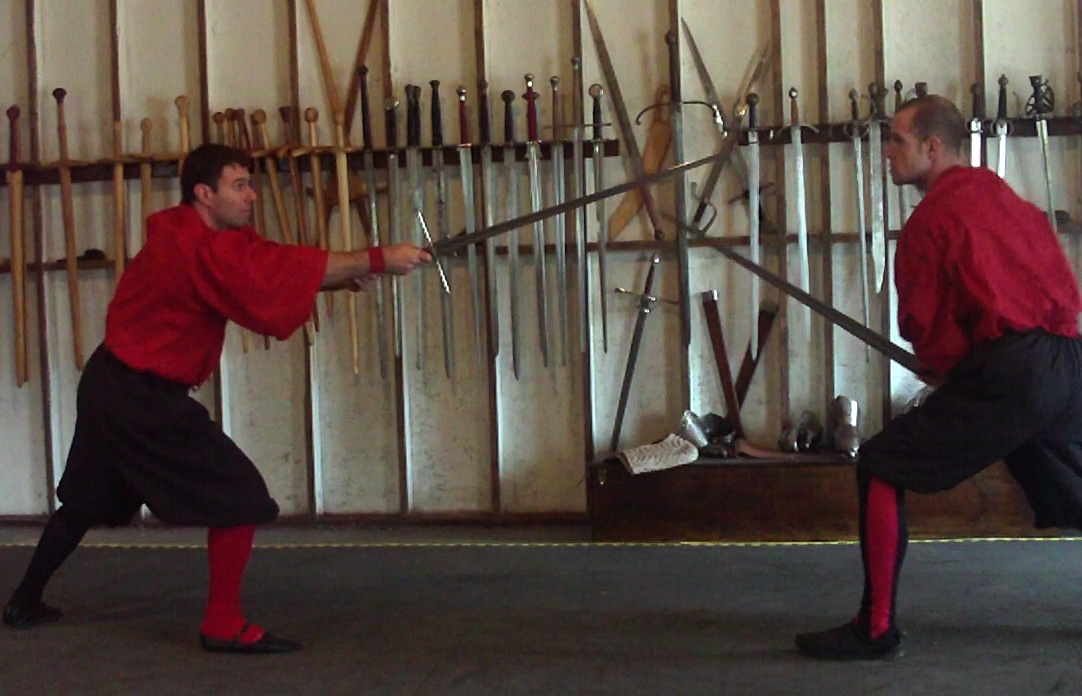 ARMA
practice reflects that while later fencing became synonymous
with gentlemanly duels of the single-sword, historical European
martial arts represented a diversity of sophisticated and
highly effective styles using a variety of weaponry and
armors for war, judicial combat, and personal self-defense.
ARMA classes reflect understanding that all-out the life
or death fighting of Medieval combat and Renaissance frays,
rencounters, and
streetfights are far removed from the more limited academic
fencing of both 18th - 19th century
gentlemen and today’s sporting styles.
ARMA
practice reflects that while later fencing became synonymous
with gentlemanly duels of the single-sword, historical European
martial arts represented a diversity of sophisticated and
highly effective styles using a variety of weaponry and
armors for war, judicial combat, and personal self-defense.
ARMA classes reflect understanding that all-out the life
or death fighting of Medieval combat and Renaissance frays,
rencounters, and
streetfights are far removed from the more limited academic
fencing of both 18th - 19th century
gentlemen and today’s sporting styles.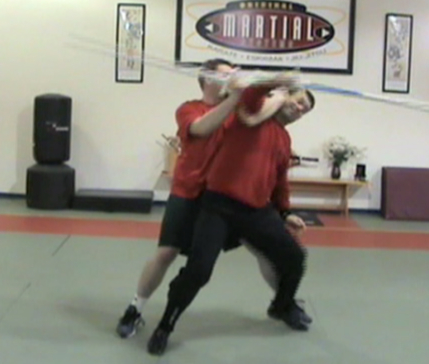 ARMA
is no mere “Internet network”; it is a truly
international organization with students or members across
North America and in several countries studying under a
proven system of historical fencing practice. Members
hold as objectives: researching, conducting mock-fights,
and sharing experience, insights, and practice opportunities.
A major ARMA goal is to reclaim our martial heritage from
its myths and misconceptions. ARMA is not a fantasy
society, role-playing organization, or theatrical-performance
troupe. These activities are contrary to sincere pursuit
of a genuine martial discipline. We don't pay lipservice
to the source teachings of our craft and then do displays
and fighting games, we try to revive the lost tradition as
a modern discipline.
ARMA
is no mere “Internet network”; it is a truly
international organization with students or members across
North America and in several countries studying under a
proven system of historical fencing practice. Members
hold as objectives: researching, conducting mock-fights,
and sharing experience, insights, and practice opportunities.
A major ARMA goal is to reclaim our martial heritage from
its myths and misconceptions. ARMA is not a fantasy
society, role-playing organization, or theatrical-performance
troupe. These activities are contrary to sincere pursuit
of a genuine martial discipline. We don't pay lipservice
to the source teachings of our craft and then do displays
and fighting games, we try to revive the lost tradition as
a modern discipline.
|
|
|||
|
|
|||
|
|||